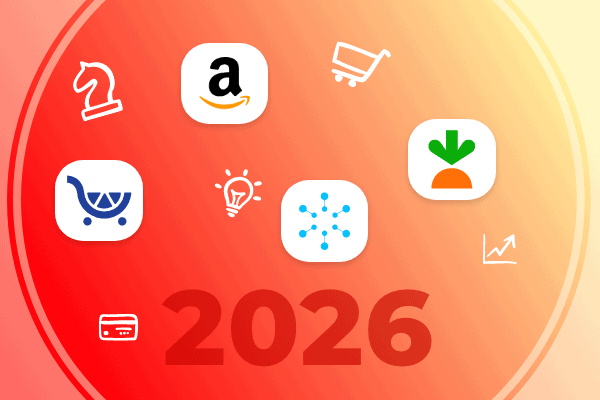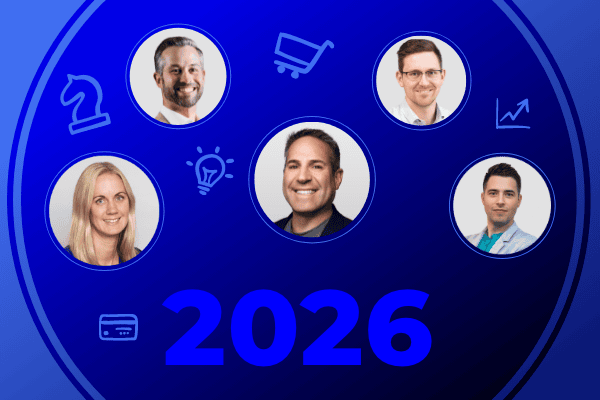Summary
Cyber 5 success isn’t won in November. It’s being decided right now. With $41B spent during last year’s Cyber 5, brands that move today across paid search, retail media, and social advertising will dominate Q4. Use proven tips and strategic tricks like phased ramp-up and data-driven automation to build momentum. Skai clients get exclusive platform guidance and advanced Celeste AI prompts to accelerate performance even faster.
Last updated: October 16, 2025 — Updated with 2024–2025 data and comprehensive FAQs.
Cyber 5 represents the make-or-break period for digital advertisers. Last year alone, consumers spent $41.1 billion during the five-day period, making it the most intense shopping stretch of the year. Yet here’s what most marketers miss: success during those five critical days isn’t only determined by what you do during Cyber 5 itself. According to Adobe Analytics 2024, U.S. shoppers generated $41.1B across Cyber Week, underscoring why disciplined preparation matters.
It’s determined by what you’re doing right now. For background, see the Cyber Five overview on Wikipedia-style resources and industry primers updated in 2025, which note Cyber Week’s growing share of seasonal spend.
Whether you’re managing retail media campaigns like Amazon Ads, paid search like Google Ads, or social advertising like TikTok Ads, the moves you make in the coming weeks will determine whether you capture or miss the momentum that defines Q4 performance. The difference between brands that thrive and those that scramble comes down to preparation that starts today. Teams running all three channels on an integrated omnichannel marketing platform can coordinate budgets, pacing, and measurement to compound gains across walled gardens.
While these best practices are universal, as a bonus for Skai clients, we’ve included tips using our platform and some Celeste AI prompts to try. Skai’s Celeste AI helps translate raw channel data into optimization actions during volatile peaks.
Micro-answer: Plan early, scale smart, convert fast.
How should you execute the three-phase ramp-up for Q4 success?
- Start now, then scale, then lock peak readiness.
- Run a “NOW→October→November” plan: test creatives and audiences early to seed retargeting; scale October momentum with deal-aware messaging; and in early November finalize expansions, retargeting, and creative refreshes so peak campaigns launch fully primed.
The holiday shopping season creeps earlier every year. November 1 became late October, then mid-October, and now early October seems to be where we’ve landed. It’s about executing a phased media strategy that drives results at every stage.
Phase 1: NOW until October 1 – Foundation and Early Capture
Start spending at moderate levels immediately. This phase focuses on testing and building the foundation for the phases ahead. Test creative variations and messaging approaches while competition is lower and costs are more manageable. Build critical audience pools for retargeting – these channels are walled gardens that use backend data for targeting, so every dollar spent now creates valuable audience segments you can leverage during peak periods. McKinsey’s Holiday Shopper 2024 found many consumers plan and research weeks ahead, reinforcing the ROI of early audience building.
Use this phase to learn and adjust for Phase 2. Which creative resonates? Which audiences engage most? Which products generate unexpected interest? Since 36% of consumers begin deal-hunting a month before major sales, your testing data will inform how to capture these early researchers when they’re ready to buy in October.
And remember, you might also capture immediate sales from early shoppers who make impulse purchases or want to avoid the holiday rush entirely.
Phase 2: October 1 – November 1 – Scale and Momentum
This is your main ramp-up period. Increase spend above September levels across all channels. Scale the successful campaigns and creative from Phase 1, and launch full promotional campaigns targeting early deal hunters. 83% of shoppers sometimes hold off on big purchases until sale events, so your messaging should balance immediate value with anticipation for bigger deals ahead. Adobe’s 2024 Cyber Monday recap shows shoppers concentrate spend during marquee events, validating pre-event seeding paired with event-time capture.
Focus on products and themes that seed consumer research and consideration. When someone discovers your weighted blanket in a social ad during October, they’re likely to search for best weighted blankets closer to Black Friday. Your October investment pays dividends across channels throughout the season.
Phase 3: November 1 – Cyber 5 – Peak Preparation
Execute final optimizations and creative refreshes based on Phase 1 and Phase 2 learnings. This is your last chance for audience expansion before peak competition drives costs up dramatically. Launch retargeting campaigns to all the audiences you’ve built over the previous phases. Coordinate timing so your peak-period campaigns launch with maximum impact.
Skai tools to accelerate your ramp-up:
- Retail media: Use Trending Products to identify SKUs/ASINs gaining momentum at scale, and apply Smart Tags in the Products Grid to uncover product trends and ensure your campaigns support them
- Paid search: Leverage Search Term Analysis with AI to streamline keyword management and uncover inefficiencies faster, plus implement Campaign Mirroring to expand audience reach to Microsoft automatically
- Social advertising: Deploy Smart Tags for Optimization to automatically identify popular products for October promotion, and use Third-party Audience Integration to expand reach and connect with new customers ready for holiday shopping
Try this advanced Celeste prompt: Analyze October 1-31, 2024 Amazon search ad performance. Show top 10 ads with ROI >2x ranked by revenue. Then segment these results by campaign name and campaign type, ranking segments by cost efficiency (revenue per dollar spent). Provide Q4 2025 budget allocation recommendations with specific percentage increases and projected volume growth for each segment tier.
How do you build flexible campaigns for peak-season chaos?
- During Cyber 5 volatility, you need structures and rules that let you shift budgets and creative in hours, not days.
- Design for rapid budget and creative pivots.
- Create granular structures by product/audience, pre-stage rules for budget and bid shifts, and define creative swap triggers so teams can react to CPC swings between Black Friday and Cyber Monday without waiting on approvals.
Most of the year, there’s a comfortable middle ground between using a lot of campaigns for granular control and using fewer campaigns for management simplicity. Cyber 5 isn’t most of the year.
The flexibility imperative. You need campaign structures that allow you to quickly tweak individual tactics like pausing underperforming segments, adding budget to winners, or swapping creative where engagement falls. Last year’s data showed massive CPC swings between Black Friday and Cyber Monday, and you need to be ready to shift spend in hours, not days. As Nielsen 2025 reports, streaming now claims the largest share of TV usage; ad-supported environments keep evolving rapidly, so creative freshness and pacing safeguards are essential.
Budget reallocation systems should be set up now. Create automated rules where possible, establish clear protocols for manual adjustments, and get approval processes in place for moving budgets quickly between channels based on performance. When social engagement spikes, you can predict search volume increases 2-3 days later, you need systems that can respond immediately.
Creative refresh cycles deserve equal attention. 58% of shoppers research products further after seeing streaming TV ads, and retail media ad visibility jumped from 56.9% to 82.3% over just three years. Creative fatigue can kill momentum fast. Plan multiple creative variants and establish triggers for swapping them based on engagement metrics.
Structure by channel for maximum agility. Retail media campaigns should be separated by product category, deal type, and targeting strategy. Paid search needs granular ad groups by product, intent level, and device. Social advertising should be split by creative format, audience type, and funnel stage.
The extra management effort pays off when you can respond to real-time performance shifts during the most competitive shopping period of the year.
Skai tools for flexible campaign management:
- Retail media: Implement Advanced Automated Actions to set multi-level conditions and automated rules based on inventory levels, plus use Pacing Monitor to track sponsored ad spend throughout the quarter
- Paid search: Set up Skai Portfolios to group similar performing campaigns with the same KPI goals for optimization, and use Bulk Edit to pause and archive irrelevant campaign elements during peak season
- Social advertising: Deploy AI-powered Pacing Monitor to keep campaigns on track with real-time adjustments, and leverage Rules-based Automation for repetitive tasks to free up time for strategic decisions
Try this advanced Celeste prompt: Review past 7 days of campaign data across retail media. Identify campaigns with daily budgets <$500 and stable performance (CVR variance <20%). Create a list of ideas for Black Friday weekend optimization rules I can make with specific trigger thresholds: increase budgets 50% when ROAS >3.0x, decrease budgets 25% when cost per conversion exceeds 125% of the campaign baseline.
How can you leverage data to amplify your entire commerce ecosystem?
- Treat channels as an interdependent system—using insights from one to power the next.
- Build a cross-channel flywheel of insights.
- Use last year’s Cyber 5, Prime Day, and Oct-Nov performance to shape audience seeds, keyword/product focus, and timing; apply retail media conversions to social lookalikes, route social-sparked queries into search, and let search terms inform retail media targeting and pricing strategies.
Every piece of data you have access to should inform your Cyber 5 strategy. 2024 year-to-date performance, Prime Day results, last year’s Cyber 5, your October ramp-up, etc., even one small golden nugget of wisdom can completely change your approach and be the difference between success and failure. McKinsey’s holiday trend brief 2024 highlights early deal-seeking and value sensitivity—pairing neatly with cross-channel planning.
But here’s the critical shift: don’t optimize in a vacuum. Plan with awareness that your channel connects to others. When you plan social discovery campaigns, anticipate the search behavior they’ll generate. When planning search campaigns, consider how they’ll drive retail media traffic. When you plan retail media campaigns, think about how conversion data could inform future social and search efforts. Remember that 2025 streaming share gains (Nielsen 2025) also reshape top-of-funnel exposure patterns that cascade into search and retail
The data sources that matter most. Last year’s Cyber 5 performance reveals which products, audiences, and messages drove the highest ROI. 49.9% of consumers expected to spend the same or more during summer sales. Review your 2024 results and apply these learnings to your holiday behavior patterns.
Economic indicators tell a complex story. 62% of shoppers may cut back spending due to inflation, but 83% would consider spending more if they anticipated future price increases. Category trends reveal strategic opportunities: pet products showed 82.6% interest in summer sales (the only category to grow), while toys dropped nearly 18 points over two years. Use these insights for holiday portfolio planning.
Cross-channel data applications that create momentum. Use recent retail media conversion data to build lookalike audiences for social advertising. Apply search keyword performance to inform retail media product targeting. Leverage social engagement patterns to optimize search campaign timing. Monitor that 88% of shoppers check for better prices via search engines and plan cross-channel pricing strategies accordingly.
The brands that implement ecosystem-aware data strategies don’t just see better individual channel performance (they build sustainable momentum that carries beyond the season).
Skai tools for data-driven flywheel optimization:
- Retail media: Use Competitive Insights to examine channel landscape and measure brand positioning on important keywords, and leverage AMC Audience Creation Flow to build custom audiences based on past purchases and cart abandonment
- Paid search: Deploy Intent Driven Messaging to better align ads with user search intent, and implement Destination Optimization to drive traffic to landing pages most likely to convert
- Social advertising: Utilize Creative AI Insights to automatically classify creative elements and identify top performers, and leverage Dynamic Commerce Ads that update product metadata in real-time for maximum relevance
Try this advanced Celeste prompt: Analyze past 60 days of social campaigns with CTR >2%. For high-performing social campaigns, identify top messaging themes, targeting segments, and creative elements. Then analyze search campaign performance in the same period to identify keyword opportunities and audience expansion potential. Recommend retail media keyword targeting and audience expansion strategies based on social campaign insights, with projected performance lift estimates.”
Why invest in your commerce media ecosystem for cross-channel returns?
- Your goal isn’t channel wins—it’s compounding wins across the ecosystem.
- Optimize to energize the entire journey.
- Coordinate messaging, product focus, and calendars so social discovery fuels search, search routes to retail destinations, and retail insights refine audience and creative strategy—extending benefits well beyond Cyber 5 into Q1.
Here’s the strategic shift that transforms performance: optimize not just for your channel-driven sales, but for your entire commerce media ecosystem. An investment into your ecosystem today creates compounding returns across all touchpoints.
What is your commerce media ecosystem? Your commerce media ecosystem is the interconnected network where 75% of global digital advertising budgets already flow (retail media, paid search, and social advertising working together whether you coordinate them or not). Consider how customers discover and buy a new laptop: they see a sponsored post on Instagram showcasing features, search “best laptops 2024” on Google later that day, compare models on Amazon and Best Buy, watch YouTube reviews, return to Google for “laptop deals,” and finally purchase through a retailer’s mobile app after seeing a targeted display ad.
That’s six touchpoints across five platforms before one purchase. Your customers experience one fluid journey where each interaction builds momentum toward conversion.
You already have a commerce media ecosystem operating. Here’s the insight most teams miss: you already have a commerce media ecosystem operating across retail media, paid search, and social advertising. The question isn’t whether you’re in the ecosystem—it’s whether you’re optimizing it or letting momentum scatter in different directions.
Even if you never talk to other channel teams, you can design campaigns to generate momentum that flows between channels. When you use your channel not just to drive direct sales but to add energy to your total commerce media ecosystem, it eventually helps you because this ecosystem operates like a flywheel—each touchpoint accelerates the next.
If you’re running social discovery campaigns, include product model numbers that search teams can naturally target. If you’re in search, guide users toward conversion-ready retail destinations. If you’re in retail media, use conversion data to inform audience strategies across other channels. Plan audience data flow in both directions and create segments that you can share, building targeting based on insights from other touchpoints.
The infrastructure advantage these channels provide. These three channels dominate because they’re the most mature advertising infrastructure with sophisticated targeting, real-time measurement, and direct connection to purchase intent. They capture the essential touchpoints where consumers naturally discover, research, and purchase. With over 80% of shoppers recalling ads on major retailer websites and 58% researching products further after seeing streaming TV ads, these touchpoints are where conversion actually happens.
You don’t need integration to participate effectively. The mindshift isn’t about forcing cross-channel coordination (we’ve tried that for 20 years). Instead, recognize that these channels are already working together in the market, whether you control them or not. Your social campaigns influence search behavior. Your search campaigns drive traffic to retail sites. Your retail media performance provides insights for social targeting.
Practical coordination comes down to three elements: consistent messaging themes using unified taglines and value propositions across all channels while optimizing format for each platform; seamless product focus that includes elements making handoffs between channels seamless (model numbers in social ads, specific product searches in paid search, matching product highlights in retail media); unified promotional calendars that coordinate timing so urgency tactics create momentum that carries forward rather than dead-ending in your channel.
Extended marketing alignment means coordinating with email, influencer partnerships, PR, and other marketing activities to create a unified customer experience. When 74% of consumers would choose a trusted retailer over an unknown cheaper seller, and only 26% have made purchases based on influencer recommendations, consistent brand presentation across all touchpoints becomes critical for conversion.
Skai tools for cross-channel coordination:
- Retail media: Use Skai’s insightful grid of dashboards to analyze sponsored and display ads together, and implement Digital Shelf Intelligence to monitor and optimize product listings with integrations from top retailers
- Paid search: Leverage Cross-channel Integration to seamlessly connect search campaigns with social and retail channels, and use customizable dashboards to monitor KPIs and track performance in real-time across all channels
- Social advertising: Integrate paid social with paid search and retail media for seamless customer journey, and use Segment Asset Customization to serve custom creatives to each audience member based on location
Try this advanced Celeste prompt: Analyze past 60 days of retail media campaigns with conversion rates >5%. Segment high-performing campaigns by campaign goal (awareness, conversion, etc.) and identify top messaging themes from ad copy. Rank campaigns by revenue and conversion rate performance. Then provide targeting recommendations for social campaign expansion, including projected CVR benchmarks and a 90-day budget scaling plan with specific ROI targets for each audience segment.
How do you dominate the post-Cyber 5 opportunity competitors miss?
- Your richest learning window arrives after the peak—use it to compound gains into Christmas and Q1.
- Turn Cyber 5 learnings into a 21-day accelerator.
- Run daily reviews, reallocate budget to proven audiences and products, A/B test creative informed by Cyber 5, expand retargeting pools, and convert return-driven shoppers with accessories and replacements—then roll insights into Q1 planning.
Here’s the non-intuitive strategic move most competitors will miss: the three weeks between Cyber 5 and Christmas represent your biggest optimization opportunity of the entire season.
Why post-Cyber 5 matters more than most realize. Our data showed sustained elevated spending after Cyber Monday, with retailers maintaining momentum for consumers who were exposed but didn’t convert during the peak period. But there’s more to it than that.
Cyber 5 is a period of major consumer engagement where you can learn more about your audience, products, and messaging in five days than in most entire quarters. Which creative resonated? Which products drove unexpected demand? Which audiences converted at higher rates? How did cross-channel momentum actually flow?
The learning goldmine that informs everything. Use these insights to optimize your final holiday push. Consumers who figured out what they wanted during Cyber 5 but didn’t buy are still in-market. Others return items and need replacements. Some buy gifts and realize they need accessories or complementary products.
The behaviors you observe during Cyber 5 will inform your entire next year strategy. Early 2025 brings post-holiday shopping patterns, including returns, accessory purchases, and “New Year, New Me” shopping. The data you collect now sets you up for Q1 success.
Your post-Cyber 5 action plan. Daily performance reviews during the three-week period should include rapid budget reallocation capabilities. A/B test new creative based on Cyber 5 learnings. Expand audiences using high-performing segments identified during the peak period. Prepare Q1 campaigns using holiday conversion data and audience insights. Capitalize on the fact that 69% of shoppers are less likely to return deeply discounted items—use this insight to inform post-holiday messaging.Use GenAI copilots like Celeste AI to turn high-volume logs into prioritized experiments and budget plays for the final push.
Skai tools for post-holiday momentum:
- Retail media: Leverage Amazon Marketing Cloud’s path to purchase data to optimize ad formats and campaigns with the strongest performance, and use Automated Keyword Harvesting to capture trending keywords from the holiday period
- Paid search: Implement Experiments to review A/B test outcomes and apply successful combinations to 2025 strategies, and use Budget Navigator to forecast optimal outcomes for Q1 planning
- Social advertising: Use Creative Center to monitor and compare performance insights across channels for data-driven decisions, and use AI-enhanced Dayparting insights to optimize 2025 ad scheduling based on holiday learnings
Try this advanced Celeste prompt: Analyze Cyber 5 period (Nov 29-Dec 3, 2024) campaign performance to identify campaigns with CTR >3% but conversion rates <1%. Segment these high-traffic, low-conversion opportunities by creative type, audience segment, and traffic volume. Rank by total click volume potential. Provide 21-day optimization roadmap including: specific creative element adjustments, audience targeting refinements, landing page recommendations, and projected conversion rate improvement targets with timeline milestones
Conclusion: Position yourself at the center of every journey that matters
The Cyber 5 period has become the ultimate proving ground for commerce media effectiveness. With 75% of digital budgets flowing to retail media, paid search, and social advertising, success requires thinking beyond individual channel optimization to commerce media ecosystem acceleration.
The brands that master this approach don’t just win during the holiday season—they build momentum that carries into 2025 and beyond. By executing your three-phase ramp-up, building flexible structures, using data strategically, coordinating messaging to energize your ecosystem, and planning for post-Cyber 5 optimization, you’re positioning yourself at the center of virtually every customer journey that matters.
Need some holiday help? It’s not too late to uplevel your tech for the holidays!
Skai is the leading omnichannel advertising platform for commerce media, combining advanced digital marketing capabilities with commerce insights and operations to drive growth for brands and agencies. Powered by unified data and proprietary GenAI, Skai delivers full-funnel media planning, optimization, and measurement, plus insights and automation that help brands improve digital shelf performance, retail execution, and revenue recovery. This integrated approach maximizes sales, profitability, and market share across media and commerce touchpoints.
Ready to accelerate your commerce media flywheel this holiday season? Schedule a quick demo to see how unified strategies drive results during peak shopping periods and beyond.
Footnotes:
- Skai Cyber Five 2024 Analysis
- Skai 2025 Summer Deals Survey
Related Reading
- LG’s Revenue Jumps 71% on Black Friday & Cyber Monday with Amazon Advertising, iCrossing & Skai— Event-based optimizations and fast issue-flagging drove 71% YoY revenue growth and a 42% ROAS lift.
- Tinuiti Drives 24% Revenue Growth Through AI-Powered Amazon Optimization for Full Moon Pet— Portfolio Optimization and Budget Navigator focused spend on winners for a 24% revenue increase without higher budgets.
- How Acosta Group Streamlined Reporting and Empowered Its Team with Celeste AI— Promptable insights replaced manual reporting, cutting cycle time from hours to minutes across accounts.
Frequently Asked Questions
Start testing creatives, building audiences, and capturing early demand now. Early spend builds data and momentum for October and beyond.
Use flexible structures by product, audience, and format. This enables fast budget shifts, creative swaps, and real-time optimizations.
It’s a key window for follow-up purchases. Use Cyber 5 insights to retarget, adjust creative, and prep Q1 based on observed behaviors.
Glossary
Cyber 5 Strategy —A coordinated, three-phase plan for the five-day Thanksgiving-to-Cyber-Monday period that uses early audience building, October scaling, and November retargeting to maximize conversions and inform Q1 planning.
Commerce Media Ecosystem — An interconnected network of retail media, paid search, and paid social that shares data and momentum across touchpoints to raise total conversions.
Pacing Monitor — A control system that watches intraday/daily spend vs. targets and triggers adjustments so budgets land precisely during peaks.
Portfolio Optimization — An algorithmic method that groups campaigns with shared goals to reallocate bids/budgets toward the highest-return opportunities.
Celeste AI — Skai’s GenAI layer that synthesizes data and recommends actions (budgets, bids, audiences, creative), accelerating analysis during peak volatility.







